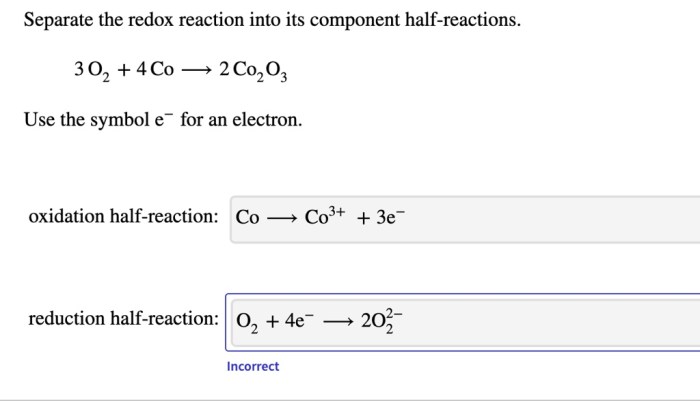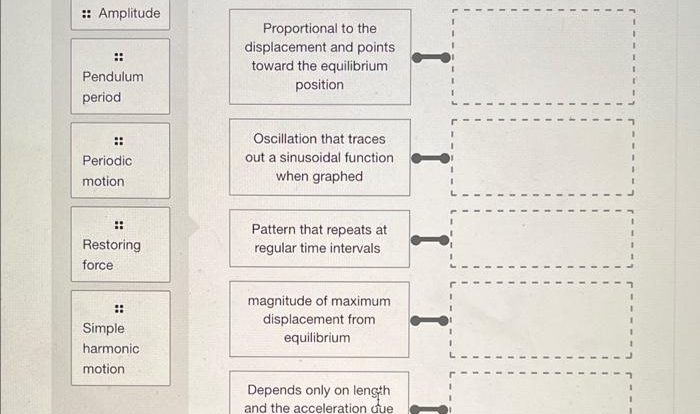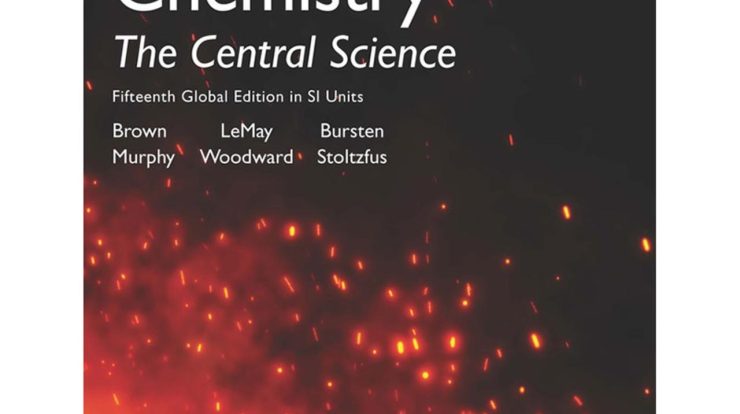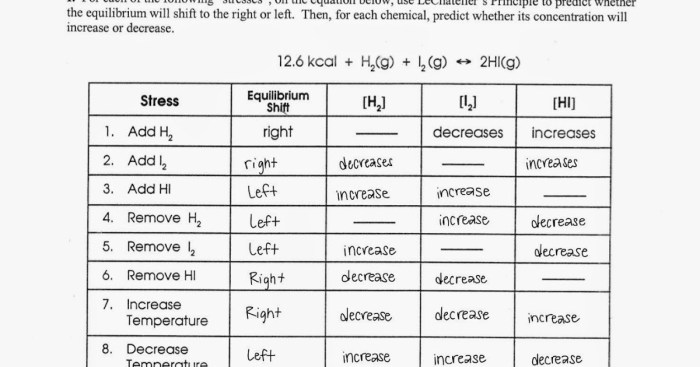Embark on an enthralling journey into the realm of chemistry with our Empirical and Molecular Formulas Worksheet. This comprehensive guide will illuminate the fundamental concepts of empirical and molecular formulas, equipping you with a deep understanding of chemical composition.
Prepare to unravel the secrets of molecular structures, explore the relationship between empirical and molecular formulas, and master the techniques for determining both types of formulas. Immerse yourself in a world of chemical calculations and gain a profound appreciation for the intricacies of chemical bonding.
Empirical and Molecular Formulas

In chemistry, the empirical formula of a compound represents the simplest whole-number ratio of atoms of each element in the compound. The molecular formula, on the other hand, represents the actual number of atoms of each element in a molecule of the compound.
Examples, Empirical and molecular formulas worksheet
For example, the empirical formula of glucose is CH 2O, which means that for every carbon atom in glucose, there are two hydrogen atoms and one oxygen atom. The molecular formula of glucose is C 6H 12O 6, which means that a molecule of glucose contains six carbon atoms, twelve hydrogen atoms, and six oxygen atoms.
Relationship between Empirical and Molecular Formulas
The empirical formula of a compound can be used to determine its molecular formula if the molar mass of the compound is known. The molecular formula is always a multiple of the empirical formula.
Determining Empirical Formulas
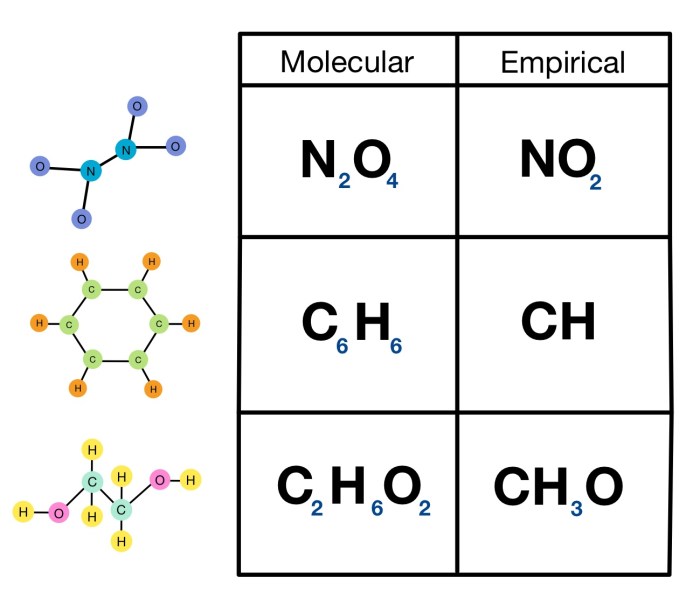
Steps
- Determine the mass of each element in the compound.
- Convert the mass of each element to moles.
- Divide the number of moles of each element by the smallest number of moles.
- Multiply the result by a whole number to obtain whole-number ratios.
Methods
There are several methods for determining the empirical formula of a compound, including combustion analysis, elemental analysis, and mass spectrometry.
Examples, Empirical and molecular formulas worksheet
For example, if a compound is found to contain 12.01 g of carbon, 2.016 g of hydrogen, and 32.00 g of oxygen, the empirical formula of the compound can be determined as follows:
- Convert the mass of each element to moles:
- Carbon: 12.01 g / 12.01 g/mol = 1.00 mol
- Hydrogen: 2.016 g / 1.008 g/mol = 2.00 mol
- Oxygen: 32.00 g / 16.00 g/mol = 2.00 mol
- Divide the number of moles of each element by the smallest number of moles (1.00 mol):
- Carbon: 1.00 mol / 1.00 mol = 1
- Hydrogen: 2.00 mol / 1.00 mol = 2
- Oxygen: 2.00 mol / 1.00 mol = 2
- Multiply the result by a whole number to obtain whole-number ratios:
- Carbon: 1 x 2 = 2
- Hydrogen: 2 x 2 = 4
- Oxygen: 2 x 2 = 4
Therefore, the empirical formula of the compound is C 2H 4O 2.
Determining Molecular Formulas
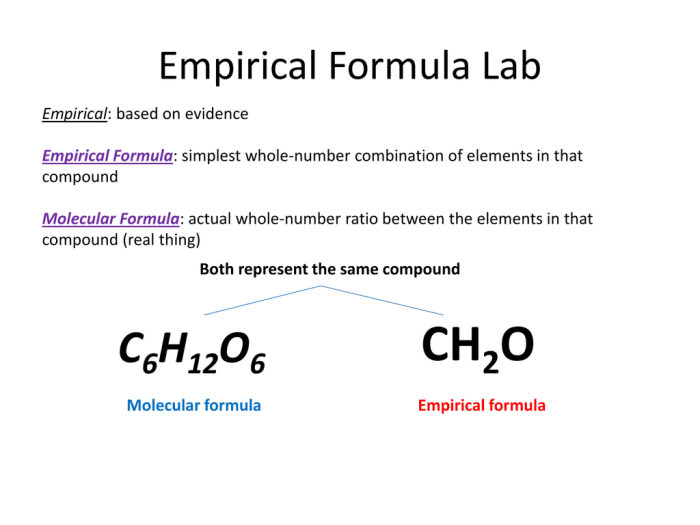
Relationship to Empirical Formulas
The molecular formula of a compound is always a multiple of the empirical formula. The ratio of the molecular formula to the empirical formula is called the molecular mass multiplier.
Steps
- Determine the empirical formula of the compound.
- Determine the molar mass of the compound.
- Divide the molar mass by the empirical formula mass.
- Multiply the empirical formula by the molecular mass multiplier to obtain the molecular formula.
Examples, Empirical and molecular formulas worksheet
For example, if the empirical formula of a compound is CH 2O and the molar mass of the compound is 60 g/mol, the molecular formula can be determined as follows:
- Determine the empirical formula mass:
- CH 2O: (12.01 g/mol) + (2 x 1.008 g/mol) + (16.00 g/mol) = 30.03 g/mol
- Divide the molar mass by the empirical formula mass:
- 60 g/mol / 30.03 g/mol = 2
- Multiply the empirical formula by the molecular mass multiplier:
- CH 2O x 2 = C 2H 4O 2
Therefore, the molecular formula of the compound is C 2H 4O 2.
FAQs: Empirical And Molecular Formulas Worksheet
What is the difference between an empirical formula and a molecular formula?
An empirical formula represents the simplest whole-number ratio of elements in a compound, while a molecular formula indicates the exact number of atoms of each element in a molecule.
How do I determine the empirical formula of a compound?
You can determine the empirical formula by finding the mass percent of each element in the compound and then converting these percentages to mole ratios.
How do I determine the molecular formula of a compound?
To determine the molecular formula, you need to know the empirical formula and the molar mass of the compound.
